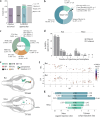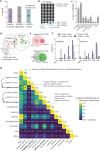Challenges and Opportunities in Exploring Non-Motor Symptoms in 6-Hydroxydopamine Models of Parkinson's Disease: A Systematic Review
- PMID: 39901598
- PMCID: PMC11791392
- DOI: 10.1111/jnc.70008
Challenges and Opportunities in Exploring Non-Motor Symptoms in 6-Hydroxydopamine Models of Parkinson's Disease: A Systematic Review
Abstract
Parkinson's disease (PD) is a neurodegenerative disorder characterized by the progressive loss of midbrain dopaminergic neurons, leading to motor symptoms such as tremors, rigidity, and bradykinesia. Non-motor symptoms, including depression, hyposmia, and sleep disturbances, often emerge in the early stages of PD, but their mechanisms remain poorly understood. The 6-hydroxydopamine (6-OHDA) rodent model is a well-established tool for preclinical research, replicating key motor and non-motor symptoms of PD. In this review, we systematically analyzed 135 studies that used 6-OHDA rodent models of PD to investigate non-motor symptoms. The review process adhered to the Preferred Reporting Items for Systematic Reviews and Meta-Analyses (PRISMA) guidelines. Our analysis highlights the growing use of 6-OHDA PD models for experimental research of non-motor symptoms. It also reveals significant variability in methodologies, including choices of brain target, toxin dosage, lesion verification strategies, and behavioral assessment reporting. Factors that hinder reproducibility and comparability of findings across studies. We highlight the need for standardization in 6-OHDA-based models with particular emphasis on consistent evaluation of lesion extent and reporting of the co-occurrence of non-motor symptoms. By fostering methodological coherence, this framework aims to enhance the reproducibility, reliability, and translational value of 6-OHDA models in PD non-motor symptom research.
Keywords: 6‐OHDA; Parkinson's disease; anxiety; depression; preclinical; rodent; sleep; social interaction; striatum; substantia nigra.
© 2025 The Author(s). Journal of Neurochemistry published by John Wiley & Sons Ltd on behalf of International Society for Neurochemistry.
Conflict of interest statement
The authors declare no conflicts of interest.
Figures





References
Publication types
MeSH terms
Substances
Grants and funding
- Conselho Nacional de Desenvolvimento Científico e Tecnológico
- APQ-00246-21/Fundação de Amparo à Pesquisa do Estado de Minas Gerais
- APQ-02074-24/Fundação de Amparo à Pesquisa do Estado de Minas Gerais
- APQ-02859-23/Fundação de Amparo à Pesquisa do Estado de Minas Gerais
- BPD-00738-22/Fundação de Amparo à Pesquisa do Estado de Minas Gerais
LinkOut - more resources
Full Text Sources
Medical

